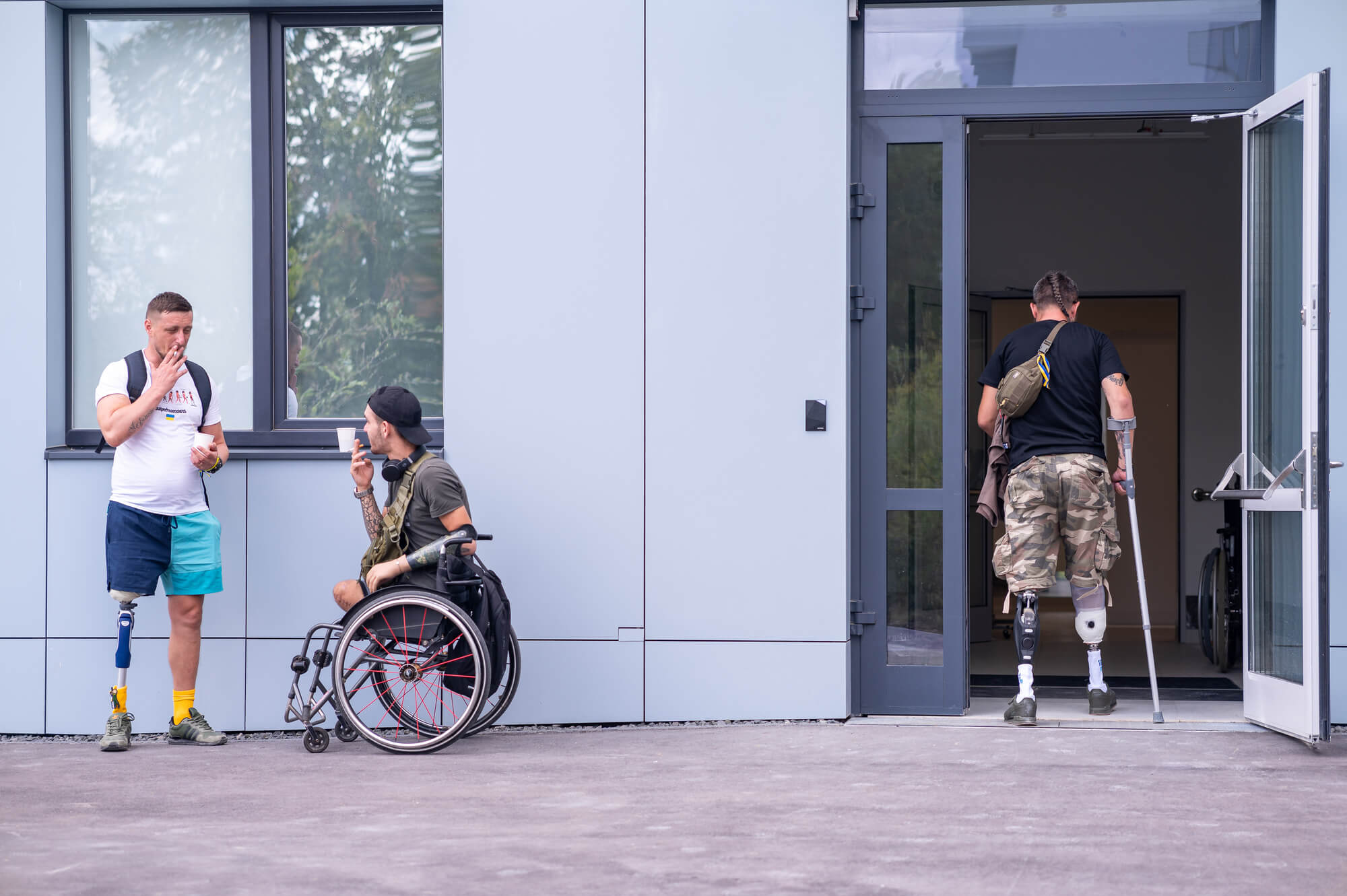One of the issues that were raised rather unexpectedly in the process of discussing constitutional amendments in Ukraine in 2015 was the right to armed self-defence, initiated by an e-petition to President Poroshenko and supported by an NGO “The Ukrainian Gun Owners Association”. This led to a heated debate within the Human Rights Working Group of the Constitutional Commission, holding back the adoption of a human rights chapter. The discussion about liberalising rules for possession of weapons has additional emotional resonance in Ukraine because of the Russian aggression and military conflict in Eastern Ukraine which caused, inter alia, illegal turnover of firearms in Ukraine.
The essential idea of this briefing paper is that a constitutional right to possess firearms is not advisable for a number of reasons. In particular, addressing this issue at the constitutional level is extremely rare, worldwide only three constitutions having it. More importantly, the idea of allowing guns to protect home and property, as proposed by the petitioners, is completely at odds with the European system of absolute protection of life. Such a provision would contradict Ukraine’s obligations within the Council of Europe and become an obstacle to integration with the EU. That said, ordinary legislation on gun ownership would benefit from being clarified. Therefore, the final part of the briefing paper touches upon some problematic aspects of the draft law on civil arms and ammunition tabled in the Ukrainian Parliament.
Introduction
The issue of a right to “armed self-defence” arose during the ongoing constitutional debates in Ukraine in 2015[1]. The discussions started with an electronic petition addressed to President Poroshenko, launched by an NGO “The Ukrainian Gun Owners Association” on 29 August 2015. The petition requests the President to:
- amend Article 27 of Ukraine’s Constitution by granting citizens a right to free possession of firearms as a means to “protect his/her life and health, home and property, the lives and health of other people, and the constitutional rights and freedoms in case of usurpation of power, violation of the constitutional order, sovereignty and territorial integrity of Ukraine. The exercise of the right to free possession of firearms is regulated by a relevant law and may be limited only by a court decision in each individual case”; and
- adopt a law “On Civil Arms and Ammunition”, a draft of which (no. 1135-1) was registered with the Ukrainian Parliament (Verkhovna Rada) on 5 February 2015[2]. The latter derives the right to bear short-barrelled firearms from the right to armed self-defence.
Within first six days upon launching, the petition was signed by the required minimum of 25 000 supporters; in total 36 244 supporters signed the petition[3]. On 24 September, President Poroshenko called on the Head of Ukraine’s Constitutional Commission (CC) to consider the request of the petitioners within the CC’s Working Group on Human Rights to involve into the respective stakeholders, i.e. the author of the petition, various political representatives, state authorities, CSOs and experts in further discussion[4]. In regards to the Draft Law, the President referred to the general legislative discretion of the Verkhovna Rada. On 27 October 2015, the suggested amendments to the Constitution were publicly discussed at a conference organised by the Working Group and attended by well-known experts and practitioners from both Ukraine and abroad. The majority of participants saw no need to guarantee the right to armed self-defence at the constitutional level. Following the conference, the Working Group commissioned a sub-group to identify legislation addressing the issue of arms and ammunition for the general Ukrainian public and to suggest improvements within the current legal framework in light of Ukraine’s international commitments. During its final meeting on 17 March 2016 the subgroup concluded that there was no need to amend the Constitution, but acknowledged the need for improvements in existing legislation, and elaborated a list of draft acts to be adopted.
This paper examines the question whether a right to possess firearms should be embedded in the Ukrainian Constitution in light of relevant European practices and standards shared by Ukraine as a member of the Council of Europe (CoE), and those common to the EU member States as a part of the EU’s acquis.
The paper concludes that there currently exist no compelling reasons to introduce the right to possess firearms in the Constitution, and elaborates on the improvement of the relevant legislation.
The right to armed self-defence and possession of firearms: ukraine’s constitution and the european framework
Current constitutional framework and suggested amendments
The Ukrainian Constitution defines the right to self-defence as a right to take action in the defence/protection of the life and health of themselves and others in Article 27(3), but lacks specification of the means by which this right may be exercised:
“Everyone has the right to protect their life and health, and the lives and health of other persons against unlawful encroachments.”
The petition to the President proposes to amend Article 27 by adding a paragraph to widen the scope of the right to self-defence, specifically by including property and home to the objects that may be defended, and explicitly mentioning the right to possess and use firearms for self-defence.
This paper identifies three specific concerns with the petition’s proposed amendments:
- This new provision would imply limitations to the “right of life” that is defined as inalienable and fundamental by the first paragraph of the very same Article 27 of the Constitution, and consequently supersedes the defence of life itself[5]. Additionally, the proposed constitutional changes would contradict Ukraine’s international legal obligations guaranteeing an absolute right to life[6].
- The proposed amendment links armed self-defence to the protection of home and property, thus creating a potentially dangerous gap in legal discourse and the possible subordination of the right to life, to the right to home and property, in other words, the defence of property could hold equal/increased legal justification as the right to life. Further, the definition of “property” could be possibly exploited to trivial objects resulting in a manifestly disproportionate privileging of property over life. This would also run counter to the overall idea of self-defence as the use of reasonable force against an unlawful threat. Furthermore, in the framework of European values and principles, the right to life should be seen as a key determinant right for all other human rights and freedoms; social, political, economic (including those of home and property). Consequently, any proposed “right” that endangers the right to life is by definition void. This has been proven numerous times in the European Court of Human Rights (ECtHR) reiterated that the right to life was a core value in democratic society which “[…] ranks as one of the most fundamental provisions in the Convention, from which no derogation is permitted”[7].
- The proposed amendment’s rationale for armed self-defence is problematic, stating the “protection of the constitutional order, sovereignty and territorial integrity of Ukraine…” as a justification for armed self-defence. Under the current Constitution the protection of sovereignty and territorial integrity of Ukraine is defined as “the most important function of the State and a matter of concern for all the Ukrainian people” (Article 17), and while Ukrainian citizens are obliged to “defend the Motherland, independence and territorial integrity of Ukraine” (Article 65) it is clearly noted that it is the responsibility of the state (not the individual citizen) to not only protect itself via the use of regulated armed forces and law enforcement agencies, but also to determine and identify “enemies of the state” and, furthermore, to use weapons against them. Granting the right at the individual level to use firearms against those who, in their eyes, jeopardise Ukraine’s constitutional order or integrity, creates a potentially catastrophic potential for abuse.
Comparison: european standards and practices
From a comparative perspective, constitutional laws regarding armed self-defence and the right to acquire, possess and use arms are rather uncommon. Reportedly, only 15 constitutions ever included an explicit right to bear firearms[8]. Only three constitutions worldwide[9] still enshrine this right[10]. They are, apart from the well-known example of the United States[11], Guatemala[12] and Mexico[13] (both envisage this right with many legislative restrictions). In addition to the historical context of the adoption of these constitutions, it is noteworthy that none of the above (three) countries belong to the European human rights paradigm. The protection of human life in the United States – a model country for most proponents of the right to armed self-defence – is not absolute. An obvious example would be the US’s use of the death penalty, which continues to be rather widespread, as opposed to CoE member states, where death penalty has been eradicated.
In the context of European values and practices, none of the European constitutions provides for armed self-defence or guarantees the right to carry or possess a firearm, at the individual level[14]. The latter is regulated usually by ordinary statutes that, at the same time are expected to meet the requirements and restrictions as developed by the CoE and the EU. The CoE addresses the topic of gun control in the Committee of Ministers’ Recommendation No. R (84)23 on the harmonisation of national legislations relating to firearms. Given the increase of crimes involving the use of a firearm and its international ramifications, the Committee of Ministers called upon member states to adopt legislation aiming to prohibit certain arms for private individuals (i.e. automatic weapons, short-barrelled weapons used to fire a lead-shot, etc.), making other types of arms subject to authorisation (i.e. firearms with barrel of less than 30 cm), and introducing an obligation to declare certain types of arms.
The EU follows the same restrictive logic in its directive 91/477/EEC as amended by directive 2008/51/EC while distinguishing between three categories of arms: 1) weapons of category “A” that are not allowed to be owned by private individuals encompass explosive military missiles, automatic weapons, and ammunition with explosive, penetrating or incendiary projectiles; 2) the ownership of weapons falling into category “B” (i.e. semi-automatic weapons, single-shot firearms with centre fire percussion) is subject to authorisation that can be granted to persons who can demonstrate a good cause, are 18 years of age or older and are not likely to be a danger to themselves, to the public order or public safety; 3) weapons of category “C” (i.e. long firearms with single-shot riffle barrel) that have to be declared. In light of the increased threat of global terrorism in Europe, namely the tragic use of illegal firearms by terrorists against civilians in Paris on 13 November 2015, the European Commission suggested amendments to the EU directive to further strengthen the EU’s fight against the trafficking of firearms by employing a more coordinated and coherent approach. To this end, the draft directive foresees stricter rules preventing the conversion of sports weapons (i.e. hunting rifles) to automatic weapons, the banning of certain types of semi-automatic weapons, common standards regarding the de-activation of weapons, and a five-year time-limit on licenses for weapons.
The approximation of weapons legislation of the EU States aims primarily to improve the control of movements of firearms across borders[15] but also seeks to generate a greater safety of persons that are threatened by the increased use of firearms. The common European Union requirements are deemed to be a minimum and do not prevent the member States from introducing stronger measures. Following these objectives, European states took adequate legislative steps, albeit with varying details of legislation. In general, national laws attempt to strike a balance between controlling the ownership of firearms, protecting personal life and accommodating justified interests of persons wishing to obtain weapons for sports, hunting or self-protection. This approach includes the regulation of the acquisition and possession of arms, provides for extensive rules on marking, registering and storage of arms, and sets grounds for revoking the license and criminal sanctions for law infringements.
For example, in Germany, the relevant provisions are laid down in an ordinary law, “Law on Weapons” (Waffengesetz[16]), which is complemented by a number of by-laws. The law establishes two categories of arms: 1) prohibited arms; and 2) arms requiring a license or authorisation, with the exception of gas pistols and alarm weapons that can be acquired without any permission. A licence can be issued only to a person who is at least 18 years of age, is physically and mentally capable of possessing a weapon, proves through a special testing the necessary technical expertise to safely operate a weapon, is able to demonstrate a need to for a weapon, and has liability insurance. In case of previous conviction for certain crimes, membership in an illegal organisation or alcohol addiction a person cannot be considered as “sufficiently reliable” to possess a weapon. A need to acquire a weapon is defined, for example, if the requesting person is in danger (such as a prosecutor investigating organised crime cases), but also if the requesting person practices target shooting as a form of sport. Furthermore, the law distinguishes between the authorisation to acquire and own a gun and the permission to carry a gun outside of one’s dwelling. For the latter, a separate request has to be filed and additional requirements have to be met. Consequently, owning or carrying a firearm without the required permission constitutes a criminal offence.
Similar legislative provisions can be found in other EU members. Switzerland is sometimes described as having a constitutional right for individuals to possess weapons. That is a misrepresentation: in Switzerland different rules on possession of firearms apply to members of the Swiss army, militia[17], and other individuals. The structure of the Swiss militia stipulates that male Swiss citizens (women may volunteer) undergo a military initial training of 18 to 21 weeks after which they return to their civil occupation with an obligation to serve a certain number of days in the military during the following years. During their initial training, members of militia are assigned a service weapon (Ordonanzwaffe, a rifle or a pistol) and are allowed to keep it at home and use at official trainings. Upon leaving the military service, members of the military may acquire their service weapon under the conditions that apply to the acquisition of firearms by private individuals. Here, the Swiss legislation follows the same classification of weapons as EU member states and differentiates between prohibited arms and arms subject to authorisation or declaration. However, rules to obtain a licence for possession of arms are less strict than in the EU countries. Essentially, with a clear criminal record a person that has no entries in its criminal record can obtain a firearm without demonstrating a special need, unless there are reasons against it. Yet, the Swiss legislation differentiates between the permission to acquire/own a weapon and the permission to carry it in public places. For the latter, the requesting person has to pass a test and to prove to be in imminent danger and an expressed need of a weapon as a means of self-defence. Furthermore, the rules set out above apply generally to Swiss citizens, while some foreigners, depending on their nationality, may be prohibited from acquiring or owning weapons.
The Firearms Act of 1968 in the United Kingdom ensures strict requirements for obtaining certain firearms which are not already prohibited by law. The respective certificate is issued by the Chief of Police of the area in which the applicant is residing. The applicant has to prove a good reason to own a firearm, whereas a simple wish to possess a firearm or to be able to defend oneself is defined as insufficient. Additionally, police may verify the general legislative requirements in each case that (among others) include witness statements about the applicant’s mental state, character, and attitude towards guns. A certificate to possess a firearm is usually valid for five years. During that time, it may be revoked for reasons specified in the law.
In France, persons wishing to acquire a firearm for purposes of self-defence may be granted an authorisation if they are able to demonstrate that they are exposed to a serious risk to their security[18].
Ukraine’s legislation on civil arms and its changes: de-regulation?
Along with proposing the introduction of a constitutional right to armed self-defence the authors of the e-petition requested the adoption of the draft law, “On Civil Arms and Ammunition”, which had been tabled for a vote in the Verkhovna Rada. Indeed, for the time being Ukraine lacks comprehensive legislation to regulate categories of arms, requirements for their acquisition and possession, arms trade control, and turnover of arms.
According to current Ukrainian legislation only hunting weapons (subject to licensing), gas pistols, pneumatic arms and “flobert” guns (weapons for conical ball cap) are permitted for private persons and legal entities. Short-barrelled firearms are allowed only to a limited range of persons (police officers, military, security forces, judges and, in some cases, other public officials).
However, the draft law encouraged by the petition introduces a state registry of firearms, categories of arms, and conditions for acquiring arms, which would be a welcomed development. It lists four categories of arms depending on their technical characteristics and thus follows a different logic than the above-mentioned European-level recommendations, wherein firearms are classified depending whether they are prohibited for private individuals, can be obtained upon authorisation, or weapons that should be declared. In addition, the first category of arms, namely pneumatic arms and “flobert” guns, can be freely obtained and used without any permission. The firearms of the second, third, and fourth categories can be obtained with a licence issued by executive authorities responsible also for maintaining the state register of firearms.
Yet, in order to fill the existing legislation gaps the suggested legal framework requires improvement in light of the above-mentioned European recommendations.
Firstly, the requirements in the proposed amendment to obtain different arms are rather liberal. In particular, the applicant does not need to prove the existing need to possess a firearm. As result, a simple desire to buy a firearm can be sufficient.
Secondly, the draft lacks the provision that the use of arms should be regarded only as a measure of last resort (for the sake of self-defence). Article 36 of the draft law states that the firearms can be used by individuals that obtained them legally to protect themselves against criminal attacks on life, health or property, or to detain a person who was caught in the act of a breaking the law, at the scene of the crime. However, according to the case law of the ECtHR, use of firearms for self-defence is justified only in cases of a direct threat to one’s life. The ECtHR recognises the legitimacy of limiting the right to life (in the context of the use of force) as the only “absolute (exclusive) necessity”. As indicated above, allowing the use of firearms for protection of one’s home and property would subordinate the right to life to the right to property, which would not be compatible with Ukraine’s international commitments[19]. Even though it is first and foremost a state’s international obligation to comply with the absolute and unconditional character of the right to life, for example by ruling out the death penalty, exceptions to this right in relations between private persons should be approached carefully and interpreted strictly.
Thirdly, this draft law provides deadly means to individuals who, being left to the justification of their own assessment of a situation, may grossly misinterpret a life-threatening situation with reliance of their own emotions; for example, a seemingly aggressive action of a suspected attacker or criminal may simply be a sign of fear. Technically, there is a lack of significant data that a common “civilian”, lacking appropriate professional training of a law enforcement officer, can adequately assess the degree of a threat and the actual necessity to use arms. In a number of judgments the ECtHR recognised that the state was actually guilty of violating the right to life in instances where police officers used their weapons against citizens when they have misinterpreted or exaggerated an alleged threat[20]. Possession of firearms by non-professionals, especially without a proper screening and training program based on proven methods and best European practices, will increase such a risk exponentially.
A number of other considerations seem to be relevant to this discussion. The majority of available data suggest that increased availability of firearm does not result in an increase in security. For example, an independent study found that in fact those in possession of a gun are 4.46 times more likely to be shot themselves than be able to use a firearm for defence[21]. A recent report from a leading independent medical organisation using data from 35 different countries also finds that the existence of liberal rights to the ownership of firearms (such as the US) significantly increases the probability of suicide, and homicide. Additionally, a psychological study published by the American Psychological Association, confirmed that people in possession of a firearm are more likely to believe others have one as well, thus increasing deadly confrontation on suspicion alone.
Further, example, from a gender perspective, while the proposed law attempts to envisage a safeguard against granting licenses to those included in the special register of persons having committed domestic violence (Article 18(7) of the draft), data has shown that such policies are very difficult to enforce, especially the retrieval of firearms from suspected perpetrators of domestic violence. While a common argument has been the proliferation of firearms to women could prevent potentially dangerous situations of domestic abuse or rape, the same study finds that any firearm in the home, are three times more likely to be murdered[22]. Additionally, the official Prevention Registry may not reflect the real number of persons committing domestic abuse, as many such instances remain unreported. The extension of the regime of joint property to firearms, which has also been proposed in the draft, could in fact endanger public order and security as the weapons would be co-owned by persons who have not undergone the proper procedure of obtaining a licence and is not in line with Ukraine’s legislation.
The general public’s attitude to the proposed changes should also be taken into account. Ukraine’s President Petro Poroshenko in his press-interview of 20 September 2015 said that only 11% of Ukrainian citizens actually supported the right to carry firearms, while 82%, including the President, were against it, though it is not clear where the data come from. Such public attitude is also stressed on by the authors of the petition.
Conclusions and recommendations
- The right to possess firearms for self-defence should not be subject to constitutional regulation. It contradicts both the rules of constitutional technique and material law.
- As the use of firearms entails an obvious threat to life, such an amendment would certainly limit the inalienable right to life that is absolute, unconditional, and based both on Ukraine’s Constitution and its international commitments. Ukraine should also be mindful of the existing regulation of firearms on the level of the Council of Europe and the European Union.
- Existing legal gaps and collisions as to arms possession and use as well as illegal turnover of firearms caused by the armed conflict in the East of Ukraine necessitate the adoption of new “gun legislation” covering all aspects of firearms possession and turnover in Ukraine on the basis of its constitutional provisions and international commitments. The principal part of such legislation should be the new Law “On Civil Arms and Ammunition”.
While determining the legal status, grounds for possession and use of firearms, the new legislation should be based on human rights and therefore aiming at the minimisation of risks for human life and health. The core principles of “gun legislation” are: the protection of the right to life (and its supremacy to other human rights including the right to property), proportionality, equal opportunities, and public security. Further, such legislation should be based on constitutional provision according to which it is the obligation of the State authorities (and not private persons) to protect life, health and property of individuals within its jurisdiction.
Notes:
[1] See the petition available in Ukrainian here
[2] See the text of the Draft Law available in Ukrainian here
[3] See here and here.
[4] The group consists of following legal experts: M. Buromensky, O. Butkevych (the author of the briefing paper), P. Fris, K. Smyrnova, V. Zbaransky, O. Marcelyak, O. Ostapenko, D. Podanchuk.
[5] See Article 27 (1) of Ukraine’s Constitution: “Every person has the inalienable right to life.”
[6] See treaties that are in force for Ukraine, in particular: The Second Optional Protocol to the International Covenant on Civil and Political Rights aiming at the abolition of the death penalty (1989), the European Convention for the Protection of Human Rights and Fundamental Freedoms (ECHR) and its Additional Protocols No. 6 (1983) and No. 13 (2002).
[7] See for example the decision in case “Putintseva v. Russia”, Judgment of 10 May 2015, application no. 33498/04.
[8] Zachary Elkins, in New York Times of 4 April 2013,
[9] Some scholars count to this group also the constitutions of Chile and some African states.
[10] See Zachary Elkins, Tom Ginsburg and James Melton, U.S. Gun rights truly are American exceptionalism, Bloomberg View, 7 March 2013
[11] The Second Amendment to the Constitution of the US reads: “A well regulated militia, being necessary to the security of a free state, the right of the people to keep and bear arms, shall not be infringed”.
[12] Article 38 of the Constitution of Guatemala reads: “The right to own weapons for personal use, not forbidden by law, in the person’s home, is recognized. It will not be obligatory to hand them over except in cases ordered by a competent judge. The right to bear arms, regulated by the law, is recognised”.
[13] Article 10 of the Constitution of Mexico reads: “The inhabitants of the United Mexican States are entitled to have arms of any kind in their possession for their protection and legitimate defence, except such as are expressly forbidden by law, or which the nation may reserve for the exclusive use of the army, navy, or national guard; but they may not carry arms within inhabited places without complying with police regulations”.
[14] See the Swiss example below.
[15] Directive 2008/51/EC was triggered by the EU’s signing of the “Protocol against the illicit manufacturing of and trafficking in firearm, their parts and components and ammunition, supplementing the United Nations Convention against transnational organised crime” of 21 May 2001, which contains, inter alia, comprehensive recommendations on marking and tracing weapons, controlling of brokers and the exchange of information on firearms between countries.
[16] This law also applies to weapons other than firearms, e.g. certain types of knives. However, due to the focus of this paper, reference is only made to the provisions on firearms.
[17] Article 58 paragraph 1 of the Swiss Constitution reads: ‘Switzerland shall have armed forces. In principle, the armed forces shall be organised as a militia.’
[18] The main rules on acquisition and possession of firearms are envisaged in Décret n° 2014-1253 du 27 octobre 2014 relatif aux dispositions des livres III, VI et VII de la partie réglementaire du code de la sécurité intérieure (Décrets en Conseil d’Etat et décrets simples).
[19] See supra No 5.
[20] See: “McCann and others v. the UK” (1995), “Andronicou and Constantinou v. Cyprus” (1997), “Ergi v. Turkey” (1998), “Ogur v. Turkey” (1999), “McKerr v. the UK” (2001), “Pretty v. the UK” (2002) etc.
[21] University of Pennsylvania (2009), see this link
[22] Ibid.
By: Olha Butkevych, Associate Professor, the Institute of International Relations of the Taras Shevchenko National University of Kyiv, and Holger Hembach, attorney-at-law, with contributions from Mykola Gnatovsky and Ruslana Vovk, DRI.
Attention
The authors do not work for, consult to, own shares in or receive funding from any company or organization that would benefit from this article, and have no relevant affiliations





